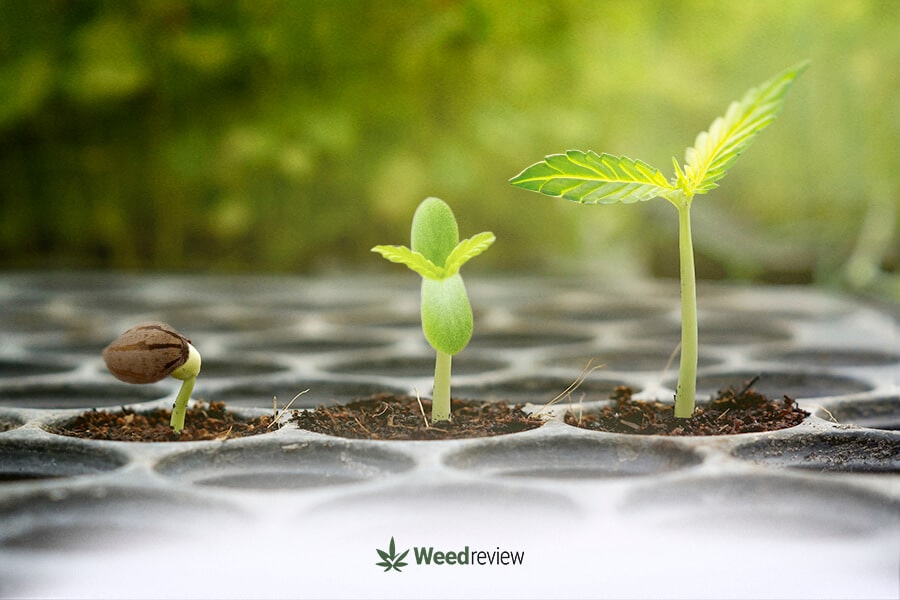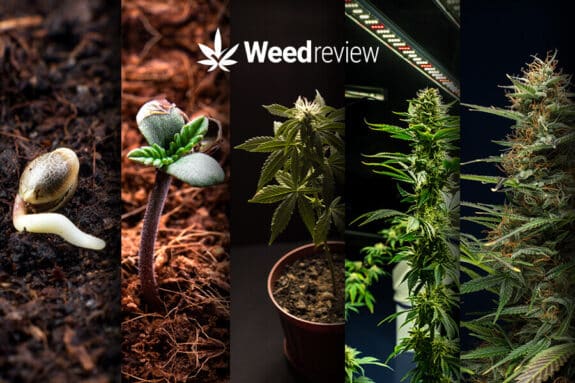
Cannabis Seeds Germination Guide: How to Sprout Marijuana Seeds

Table of Contents
Welcome to our guide on germinating cannabis seeds. This guide is designed for anyone interested in growing cannabis, from beginners to those with some experience.
Cannabis seed germination begins with sprouting, marked by the emergence of a white taproot from the seed.
This taproot, the plant’s first and main root, extends downward to anchor the plant in the growing medium while the other end pushes the seed upwards.
The first leaves, called cotyledons, appear as the seed shell cracks open. These round leaves, pre-formed within the seed, help push the shell apart. Following the cotyledons, the plant’s first true leaves with jagged edges start to grow, indicating the beginning of active growth.
We’ll explain how to germinate your marijuana seeds, covering the germination process and the steps to plant them successfully. Take a closer look at the tried-and-tested methods, essential tips for successful germination and common mistakes to avoid.
How to germinate cannabis seeds: Step-by-step
A good beginning can make all the difference in life; the same is true for cannabis. While most growers prioritise the vegetative and flowering phase, you will only have a plant to harvest if you can sprout your seeds properly.
Method 1: Glass of water
The glass of water method is a straightforward and popular technique for germinating cannabis seeds. It involves soaking the marijuana seeds in water overnight to activate the germination process.

Here’s how you do it:
- Fill a clean glass with plain, lukewarm water. Avoid using water that is too hot or cold, as it can affect the germination rate.
- Gently place your cannabis seeds into the glass of water. Healthy seeds start floating and eventually sink to the bottom of the glass.
- Keep the glass in a warm, dark place. The seeds crack open within 24-36 hours, with tiny roots emerging.
- Once the taproot is visible, carefully transfer the seeds to your chosen growing medium, ensuring the root faces downward.
- Remove any ungerminated seeds to a warm, moist place to finish sprouting.
Germinating cannabis seeds using the water glass method can be effective, but it requires careful monitoring and some specific conditions to be successful.
Ideally, seeds should be kept in water for at most 24-36 hours. Longer periods increase the risk of rotting or drowning the seeds.
Many growers like to activate their seeds by soaking them overnight. Once thoroughly soaked, they use other germination methods to sprout the seeds.
Method 2: Wet paper towel
This is another standard method growers use to germinate their cannabis seeds. It involves creating a humid environment using paper towels and water. Some versions use cotton wool pads or absorbent paper pieces to create similar conditions.

Here are the steps:
- Take a few sheets of paper towel and moisten them with lukewarm water. The towels should be damp but not soaking wet.
- Place your cannabis seeds on the towel, leaving space between each seed. Cover the seeds with a few more damp paper towels.
- Cover the setup with an upside-down bowl or sandwich it between two paper or regular plates to maintain humidity and prevent drying.
- Keep the setup in a warm place. Check for sprouting every 12 hours, typically when the white root tips reach 1–2 cm. Be careful not to disturb the taproot.
- Once sprouted, carefully transfer the seeds to soil pots, following the same planting techniques as before. Unsprouted seeds can be left in the set-up, giving them more time to germinate.
Ensure the towels are damp and not wet; too much water can suffocate the roots.
Method 3: Starter plugs
Starter plugs offer a convenient and efficient way to germinate cannabis seeds. They are specially designed mediums that provide an ideal moisture, air, and stability balance for germination. Different starter plugs, like Jiffy Pellets and Rockwool Cubes, cater to varied preferences and growing methods.

These plugs simplify the early stages of plant growth, ensuring a strong start for your cannabis plants.
Starter plugs also make the transition smooth to the growing medium. Once the seeds have sprouted, you must move the whole plug, not just the delicate taproot, with the seed.
Peat pellets

Peat pellets, often sold under the brand name Jiffy Pellets, are compact discs made of compressed peat or coconut coir that expand when soaked in water. They create a nutrient-rich, biodegradable medium for seed germination.
| Pros | Cons |
|---|---|
| Peat pellets are environmentally friendly as they naturally degrade over time. | Not suitable for hydroponic set ups. |
| They are easy to handle and transplant, minimizing root disturbance. | The pellets must be soaked before use. |
| Can be directly transferred to soil or coco coir. |
To set up the jiffy pellet system, here’s what you do:
- Start by immersing them in warm water. This causes the pellets to expand.
- Once they’ve fully expanded, gently press out any extra water. Now, they’re ready for use.
- Gently insert the seeds into the pellet, cover, and place the pellet in the grow tray.
Rockwool cubes

Rockwool cubes, also called stone wool cubes, are made from molten rock spun into cotton candy-like fibres and formed into cubes. They provide an inert and sterile growing environment for seeds.
| Pros | Cons |
|---|---|
| Excellent balance of water retention and air circulation, promoting healthy root growth. | They are not environmentally friendly as they do not degrade. |
| Well-suited for hydroponic grow systems. | The fibres can irritate skin and lungs, so handling requires caution. |
| They can maintain stable pH levels. | Rockwool cubes have an alkaline pH of around 8.0 – this must be brought down to an acidic range of 5.5 – 6.5 for growing cannabis. |
To use rockwool cubes, follow these steps:
- Soak the rockwool block in a pH 5.5-6 water solution for an hour or so. Gently squeeze out any excess liquid.
- Place the seeds in the cube and gently put the cube on the grow tray.
- Maintain the proper environmental conditions like humidity; your seeds should sprout in 3-4 days.
Method 4: Soil
Planting cannabis seeds directly in the soil is a natural and straightforward approach. It avoids transplant shock, as seeds germinate in their final growing medium. All you have to do is move them into a larger pot when they grow bigger.

Here’s how you work with soil:
- Plant seeds about 1 to 2.5 cm deep in moist, not soaked soil. Cover loosely.
- Keep the top part of the soil moist. Do not overwater or soak the soil.
- Maintain the right environmental conditions.
Seedlings typically emerge in 4-10 days and continue in regular growing conditions.
How to improve your seeds’ germination chances?
It is crucial to create the right environment and follow best practices to enhance the chances of sprouting your marijuana seeds. This section explores key factors and techniques to optimise germination rates.
Provide the right mix of water, air, temperature
Understanding and maintaining the key elements for seed germination is crucial for healthy cannabis plant development. The following are an absolute must-have:
- Temperature & warmth: Maintain an ideal 20-25°C (68-77°F) for optimal germination.
- Darkness: Keep seeds in darkness, replicating natural soil conditions and encouraging sprouting.
- Moisture: Ensure 70-90% humidity, balancing moisture without causing drying or rotting.
- Air circulation: Gentle airflow is necessary to prevent mould and promote healthy development.
- pH Range: Use pH-balanced water (5.5-6.5) for a conducive growth environment.
- Undisturbed environment: Avoid handling seeds during germination to prevent disruption.
Do not pack the soil tightly
Loose soil is critical for seed germination, allowing roots to expand quickly and air to circulate. Tightly packed soil can stop root growth and prevent them from taking in oxygen, which is critical for young seedlings. Properly aerated soil encourages robust root systems, leading to healthier and more vigorous plants.
Choose quality seeds
High-quality seeds are the foundation of successful germination. Good seeds typically have a firm texture and a mature colouration, such as dark brown or tan. These characteristics indicate a seed’s readiness to germinate and potential for healthy growth.
Avoid soft, pale, or green seeds, which are usually immature and will likely not grow into beautiful, bountiful plants.
Dip in hydrogen peroxide
A diluted hydrogen peroxide solution to soak seeds can jumpstart germination. Add 1/5th of hydrogen peroxide to 5/6th of distilled water to prepare the solution. Soak the seeds overnight for up to 12-18 hours.
This treatment gently softens the seed’s outer shell and sterilises its surface, reducing the risk of fungal or bacterial infections. This simple step can significantly enhance germination rates, especially for older or tougher seeds.
Always have extra seeds handy
Expect a few seeds to fail even with advanced growing expertise and top-of-the-line equipment. That is natural and a part of the process when dealing with plants; you can try as much as you want, but some seeds may not simply germinate.
That’s why it is often recommended to have extra seeds handy and always buy them from reputed seed banks only.
How to plant germinated cannabis seeds
Plant your seeds once they have sprouted; it is now ready to commence the seedling phase. This is where the seeds will grow their taproots and root network underground and develop their first pair of leaves above.
Plant your sprouted seeds into the medium when the taproots are 1 – 1.5 cm long. Your plant may grow slowly if you wait for the taproots to grow longer.
Here’s a short step-by-step guide on how to plant sprouted marijuana seeds:
- Choose a suitable growing medium and moisten it without making it waterlogged.
- Make a small hole about a knuckle deep (1.3-2.5 cm). Carefully place the germinated seed with the taproot facing downward.
- Avoid touching the taproot. Use tweezers or a similar tool for placement. Do not expose the roots to the light for a long time.
- Lightly cover the seed with soil, ensuring it’s not compressed too much.
- Maintain a warm and moist environment, avoiding direct, intense light initially.
Within 4-10 days, you should see the seedlings grow beautifully. Fuzzy roots will develop in the growing medium, while at the top, you will see the cotyledons emerge.
Best practices for a successful planting
For young germinated cannabis seedlings, less is more. It needs a healthy mix of humidity, light, and food – but not too much. They will be on autopilot for the first 2-3 weeks of your seedling’s life.
Maintain the right moisture balance
The soil should be damp but not soggy to encourage growth without risking mould or rot. It should be consistently moist but not waterlogged, as overwatering can lead to root rot and suffocate them, while under-watering can dry out the seedlings.
Some growers create a makeshift dome using a plastic bottle to maintain the proper humidity and moisture conditions.
Do not give too much light
In terms of lighting, young cannabis plants require a significant amount of light once they sprout. However, it is important to avoid direct sunlight or intense indoor lights during the early stages to prevent scorching.
Start with less intense lights early on and keep them a few feet away. As your seedlings grow older, you may move them closer to the light.
Provide the right environment
The overall environment should be conducive to growth, with a stable temperature and humidity level. This ensures that the seedlings are not stressed by fluctuating conditions, which can impact their growth and health.
Keep the soil healthy
Using the right soil is also crucial. Light, airy potting soil is typically recommended for cannabis seeds, as it allows for proper drainage and prevents the roots from becoming waterlogged. The soil should be loosely packed in the pot to allow air to circulate, which is vital for root development.
Do not use a large growing container
Young seedlings do not need much to grow; their water and food requirements are minimal. However, the roots do need plenty of oxygen.
Using a large container means the growing medium is wet, damp, and carrying excess food – the roots will simply ‘sit’ in that environment and wait for the medium to dry. This doesn’t mean that your plant will die; it just means the growth will be very slow.
On the other hand, a small container – like a seedling cup or a small cup – means the growing medium will dry out quickly – thus allowing you to water more frequently.
That said, using a big container at the beginning means you don’t have to transplant them as they grow older.
Do not disturb
Germinated seeds can look a lot different when growing. Sometimes, the taproot may be bent. Other times, it may seem like the plant is growing with the root pointed upward.
In either case, it is best not to interfere with Mother Nature. Do not try to reposition the seeds. You will do more harm than good.
Often, the bent, U-shaped, upside-down root you see is just the stem of the plant popping out. In a few days, you will see the cotyledons emerge while the roots are burrowing down to support this new growth.
Cannabis seeds basics: What are they, types
Cannabis seeds are the foundation of cultivating the cannabis plant, carrying the genetic code necessary for producing the various strains we know today. Each seed contains the plant’s DNA, determining its growth characteristics, cannabinoid content, resistance to pests and diseases, and other traits.
Inside a cannabis seed, you’ll find the embryo of the plant, which includes the cotyledons (the first leaves that will emerge upon germination) and a rudimentary root system. The seed also contains a small amount of stored nutrients and moisture, essential for the seed’s initial growth once germination begins. This internal structure is designed to support the seedling through its early stages of growth until it can begin photosynthesis.
Cannabis seeds come in three main types:
- Regular seeds: These are natural, unaltered seeds capable of growing into either male or female plants. They are essential for traditional breeding, as they carry the diverse genetic traits of both parent plants.
- Feminised seeds: Specially bred to eliminate male chromosomes, these seeds almost always produce female plants, which are prized for their bud production. They carry the genetic traits of the female parent, ensuring a consistent and predictable crop.
- Autoflowering seeds: These seeds are genetically modified to flower automatically after a certain age, regardless of the light cycle. They often combine the genetics of Cannabis ruderalis with other strains, resulting in plants that are resilient and easy to grow.
The choice of seed type depends on the grower’s goals, whether it’s for breeding, consistent female bud production, or a straightforward, quick grow cycle.
FAQs: Troubleshooting common problems
Mentioned below are a few questions you may find yourself while sprouting your weed seeds.
What should you do when the seeds are not germinating?
You can try soaking the seeds overnight in water with a few drops of hydrogen peroxide to soften the shells and enhance germination.
All good seeds should ideally sprout in 3-10 days. Seeds that do not will likely not germinate and should be discarded.
Apart from this, consider factors like moisture levels, water quality, temperature, and depth of planting. Avoid using tap water as it may contain additives; instead, use distilled or bottled water. Similarly, do not leave the seeds in excessive dampness as it may cause them to rot.
How long does the seedling phase last?
Plants stay in the seedling phase for 2-3 weeks after germinating.
Once they have some roots and a few pairs of leaves, they start building their vegetative system. This is where they expand their root systems and grow branches & leaves for flower production.
How do you germinate hard-shelled seeds?
Soaking in a hydrogen peroxide solution can help germinate hard-shelled seeds.
Alternatively, you can scuff the seeds a little to help with germination. Take a matchbox and put a piece of fine-grain sandpaper or emery board inside. Then, place the seeds in the matchbox and shake for 10 to 15 seconds. Once done, remove the seeds and ensure that they have been scuffed. This process will allow water to enter the seeds and set germination in motion.
Can you identify the sex of marijuana seeds?
It is not possible to determine the sex of marijuana seeds by looking at them. The sex of the plant is revealed during the pre-flowering/late vegetative stage when the plant is 6-8 weeks old.
Which is the best method for germinating cannabis seeds?
An overnight soak followed by the paper towel method is often recommended for new growers. This method is easy to monitor and often leads to good results and healthy germination.
Which method should be used for germinating in hydroponics?
Inert mediums like rockwool are best recommended for germinating the seed in a hydroponic setup. Coco coir plugs or specialised plugs for hydroponics can also be used.
How deep should you bury the cannabis seeds for germination?
Here’s a rule of thumb to remember: Plant seeds twice as deep as the seed’s width.
In practice, the range varies from 1 to 2.5 centimetres. Do not plant the seeds too deep, as it can prevent them from getting oxygen and other vital nutrients.
How long does it take for seeds to sprout?
Seeds can sprout and grow the taproot within 12-36 hours of being exposed to moisture. In some cases, it can take 3 to 10 days, depending on the medium in which it is planted and surrounding conditions.
How to store cannabis seeds?
Store cannabis seeds in a cool, dark, and dry place to maintain their viability. A common method is to keep them in a sealed container in the refrigerator, ensuring they are not exposed to light or fluctuating temperatures. This helps preserve their germination rate over time.


